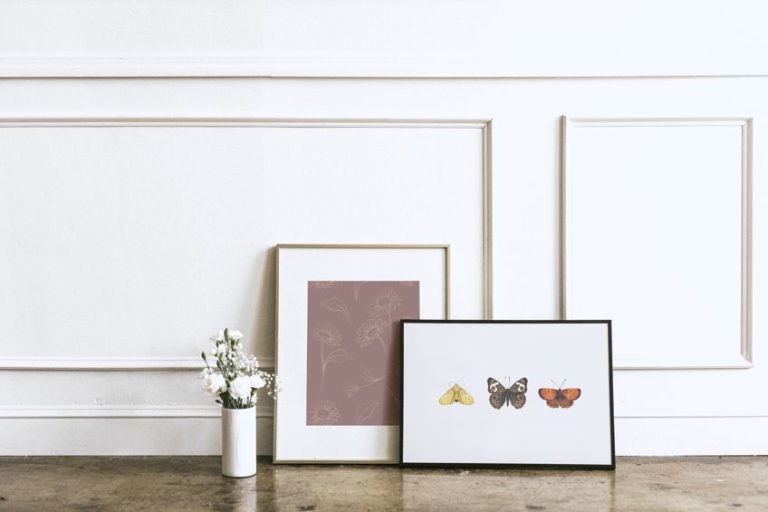Types of Visual Art – Exploring The Many Exciting Visual Art Forms
This post may contain affiliate links. We may earn a small commission from purchases made through them, at no additional cost to you.
Art is the product of applied human imagination and creativity. Art can take many forms and appeal to each of man’s five senses. When it comes to artistic pieces that must be seen with our eyes, we call them visual art. If you want to learn more about visual art and the ways in which it is expressed, you have come to the right place!
What Is Visual Art?
Let us begin with a visual arts definition. Visual art, as the name suggests, is a creative discipline centered around art that is meant to be appreciated and experienced visually. The modern definition of visual art encompasses three categories; fine art, commercial art, and decorative art. In this article, we are going to explore the history of visual art, discuss its primary categories, and delve a little deeper into its various subdivisions.

History of Visual Art
For most of history, the criteria for what constituted visual art were far less flexible than today’s standards. The term was almost exclusively used to define works of fine art, with both terms being used almost interchangeably. It would take until the turn of the 1900s before visual art would come to be a term describing other visually represented art forms besides fine art as well.
The term “artist” itself was also heavily moderated and intentionally exclusive to practitioners of fine arts such as sculpture, architecture, and painting.
By the mid-1900s, however, this philosophy was challenged by the British Arts and Crafts movement. The movement sought to revolutionize decoration and design amidst the soot-covered, unimaginative, and depressing landscape that encompassed England during the advent of industrialization. The Arts and Crafts movement inspired the understanding that practitioners of the applied arts and crafts could be considered visual artists. The movement also promoted development in the appreciation of vernacular art. The now much broader definition of visual art has come to encompass arts in applied fields such as advertising and decoration alongside the traditionally upheld fine arts.
Types of Visual Art
We can classify any work of visual art under one or more of the three primary genres. These are; fine art, commercial art, and decorative art. Here we have provided information regarding the aspects of visual art pieces that make them fall into either category.

Fine Art
We can define fine art as a visual art form based on aesthetics, imagination, as well as intellectual context. The merit of any particular work of fine art will be determined according to these parameters. Unless the intention of the artist is to be controversial or provocative, the quality of fine art is most typically determined by how visually appealing it is.
Unlike commercial and decorative visual art forms which are designed with a function (such as advertising), fine art is often considered to be its own higher class of art that is all about the expression of the artist, something which cannot be achieved by art forms that are designed for commercial or utility aspects.
That being said, however, decorative and commercial can include elements of fine art or even be considered fine art if deemed good enough. Furthermore, the definition of fine art eventually came to also include other illustrative arts, especially around the Renaissance period. In particular, sketches created during the design process of traditional arts were merited as a form of high art.

Henceforth from this period of art history, the term “fine art” was applied to differentiate traditional arts from art applied for commercial purposes as well as the laborious physical aspects of artisanal craftsmanship. The quality of a piece of fine art is determined by how effectively the technique of the artist’s chosen discipline is applied. While fine art has many disciplines, those which are considered to be examples of fine art include the following: painting, sculpture, and architecture.
Painting
Beyond even the long-past period of antiquity, painting has been around for as long as historians and archaeologists can date back to the existence of humanity itself. Inside a salt mine in Indonesia lies a cave where scientists have found hand paintings that date back to roughly 45 000 years ago, making them the earliest examples of visual arts.
The art of painting involves applying paint to a surface in a way that produces visual depictions of identifiable subjects.
Paints are made using pigments, binding agents, and fillers. Pigment is the powder that gives paint its color. Binding agents, such as eggs, are used to bond the pigment together in a liquid form. Lastly, colorless filler powders can be added to increase the quantity of paint produced without having to spend more on pigment.
Sculpture
Another ancient art form dating back beyond even the Mesopotamians, sculpture is also an artistic tradition we have been fostering since the time of Early Man. The main thing that separates sculpture from painting is the fact that it is an expression of fine art communicated in three dimensions.

To create sculpture art, artisans make use of many types of solid materials that are either worked or fused together to produce a recognizable 3-dimensional representation of a subject. Popular sculpting mediums include wood, clay, stone, and metal. Sculpture art comes in two forms, free-standing and relief.
Architecture
Architecture is the third and final example of traditional fine art. To understand what makes architecture an art, we must first understand what differentiates it from construction. Simple construction involves the creation of structures that exclusively fulfill practical requirements (e.g., for shelter).
Architecture, on the other hand, is the art of designing structures that not only fulfill their practical necessities but also fulfill aesthetic requirements as well.
The skills of an architect will be determined by the degree to which they are able to pair function and utility with beauty and aesthetics. Great examples of architectural art include the Notre Dame in France, the Sistine Chapel in the Vatican City, Big Ben in London, and the Cologne Cathedral in Germany.
Commercial Art
Commercial art differs from fine art in terms of purpose. While both of these visual art forms are typically designed to be aesthetically pleasing, commercial art is designed for the ultimate purpose of promoting goods, services, and concepts to make them more marketable. This is seen primarily in advertising where art is often used to boost sales by stimulating interest among consumers.

Commercial art is also produced and replicated on a massive scale to increase outreach. The subject matter of commercial art is also most often designed in a universally appealing manner to further maximize the interest generated among consumer bases.
Visual art examples found in commercial art include illustration, motion graphics, VFX, graphic design, printing, animation, fashion, and TV adverts. Works of commercial art are not the brainchild of the artists themselves but are commissioned by companies and brands to connect and appeal to their particular target markets.
Commercial types of visual art are the ones you are most likely to come across during your day-to-day, with their prevalence usually increasing the closer you get to hubs of business and social activity.
We are absolutely surrounded by the works of commercial artistry. Every billboard, television advertisement, publication like newspapers and magazines, cell phone application, brand logo, and poster will incorporate a degree of commercial art. If you are trying to figure out if something fits the visual arts definition of commercial art, ask yourself, “Is it advertising or promoting a product, a service, or an idea to me?” If the answer is yes, you are most likely observing a piece of commercial art.
Although we might consider commercial art to be an example of new-age media given how much it has prevailed and developed in the modern era, the history of commercial art can actually be dated back hundreds of years ago. One of the oldest examples of commercial art is the famous “Bobbles” painting produced by artist John Everett Millais in 1886. The painting depicted a child playfully making bubbles with a pipe. The piece was specifically created to be reprinted and used by Pears, a famous British soap business, as a means to advertise its products.

Commercial art and its conventions have since been repurposed for the advertising and promotion of all sorts of things, especially within the world of politics and war. A popular example of this would be the Uncle Sam poster used by The USA’s military to encourage recruitment during World War I and World War II. The poster famously depicted a fictional character called Uncle Sam pointing in the direction of the viewer with the text “I Want YOU for [the] U.S Army.” The figure was meant to be a personified representation of the American government and military.
Throughout history as well as during today’s times, in particular, commercial art has seen extensive use in propaganda. This form of visual art can be incredibly influential in swaying public opinion, for better or for worse. While commercial art may be a great communication tool, it is important for us as a society to be able to identify when it is being applied coercively. A relatively non-threatening example would be YouTube’s aggressive use of advertising in order to persuade us into paying for a premium account. An extreme example would be the use of symbology and fabricated eugenics diagrams produced by the Nazis as a means to stoke hostile nationalism.
Decorative Art
Decorative arts, much like commercial types of visual art, can be defined as art that serves both a utilitarian and aesthetic purpose. The term itself is synonymous with arts and crafts, a means through which objects that serve a physical purpose are designed in a way that makes them visually appealing.
For example, an ornately decorated vase not only serves the purpose of holding flowers but also uplifts the aesthetic quality of the location in which it is placed.
Decorative art pieces are typically ornate and crafted by an artisan with a specialized set of skills. Decorative art pieces can come in the form of ordinary objects but their aesthetic qualities will also make them easily distinguishable from regular, mass-produced versions. Carpentry, pottery, glass blowing, metalworking, and textiles are some popular examples of decorative visual art forms. Even jewelry-making is a form of ornamental decorative art.

A rather unfortunate fact about decorative art is that artists in this discipline seldomly achieve the same levels of acclaim as artists in other traditional fine art forms. This is despite the many similarities and overlaps that the decorative arts share with sculpture, painting, and architecture. That being said, however, Peter Carl Fabergé is an example of a decorative artist whose name rings out from the annals of art history thanks to his creation of the famous Fabergé eggs.
Hopefully, this article has assisted you in developing a decent understanding of exactly what is visual art as well as what are the three types of visual art. You should now have a functional understanding of what constitutes fine art, commercial art, and decorative art.
Frequently Asked Questions
Why Is Visual Art Important?
The visual arts form a crucial aspect of human history and expression. The art we produce stands as a testament to the boundless creativity and imagination innate within our species. Visual art is not only nice to look at; it also documents our culture and our history.
Is Drawing Considered a Visual Art?
Yes. Drawing is one of the most popular examples of visual arts. Even drawing made in a vernacular art style, while it may not be considered fine art, is still considered to be visual art.
What Are the Three Types of Visual Art?
Traditionally, we refer to fine art, decorative art, and commercial art as being the three primary categories of visual art. The contemporary visual arts definition has come to include film, photography, and graphic design to name a few modern additions.
What Are Some Visual Art Examples?
In fine art, some of the most famous examples would be the Mona Lisa (1505) by Leonardo da Vinci, Girl with the Pearl Earring (1665) by Johannes Vermeer, and The Starry Night (1889) by Vincent Van Gogh. In commercial art, some acclaimed examples include Campbell’s Soup Cans (1962) by Andy Warhol, Takashi Murakami’s restyling work with Louis Vuitton in 2002, and French eyewear company Keloptic’s reimagination of Van Gogh’s artwork as a means to sell glasses. In decorative art, one of the most famous examples would be the Fabergé eggs constructed by Peter Carl Fabergé. Another good example would be that of fine China, separated from ordinary dinnerware by its complex, specialized crafting process, and its often intricately painted designs.
In 2005, Charlene completed her wellness degrees in therapeutic aromatherapy and reflexology at the International School of Reflexology and Meridian Therapy. She worked for a company offering corporate wellness programs for several years before opening her own therapy practice. In 2015, she was asked by a digital marketer friend to join her company as a content creator, and it was here that she discovered her enthusiasm for writing. Since entering the world of content creation, she has gained a lot of experience over the years writing about various topics such as beauty, health, wellness, travel, crafting, and much more. Due to various circumstances, she had to give up her therapy practice and now works as a freelance writer. Since she is a very creative person and as a balance to writing likes to be active in various areas of art and crafts, the activity at acrylgiessen.com is perfect for her to contribute their knowledge and experience in various creative topics.
Learn more about Charlene Lewis and about us.







